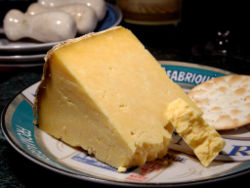- Cheshire cheese
-
Cheshire 
Country of origin England Region, town Cheshire Source of milk Cows Pasteurised Frequently Texture hard crumbly Aging time 4-8 weeks depending on variety Certification No Cheshire cheese (pronounced /ˈtʃɛʃər/) is a dense and crumbly cheese produced in the English county of Cheshire, and four neighbouring counties, two in Wales (Denbighshire and Flintshire) and two in England (Shropshire and Staffordshire).
Contents
History
Cheshire cheese is one of the oldest recorded named cheeses in British history: it is first mentioned, along with Shropshire, by Thomas Muffet in Health's Improvement (c. 1580). Indeed, Cheshire cheese is Britain's oldest cheese. There is no earlier specific mention of the cheese of the county, but the importance of Cheshire as one of the main dairy regions of England is already emphasised by William of Malmesbury in the Chester section of his Gesta pontificum Anglorum ("History of the bishops of England": c. 1125). The claim that Cheshire cheese is referred to in Domesday Book has become widespread but it is "nonsense".[1]
Cheshire was the most popular cheese on the market in the late 18th century. In 1758 the Royal Navy ordered that ships be stocked with Cheshire and Gloucester cheeses.[2] By 1823, Cheshire cheese production was estimated at 10,000 tonnes per year;[citation needed] in around 1870, it was estimated as 12,000 tons per year.[3]
Until the late 19th century, the different varieties of Cheshire cheeses were aged to a sufficient level of hardness to withstand the rigours of transport (by horse and cart, and later by boat) to London for sale. Younger, fresher, crumbly cheese that required shorter storage — similar to the Cheshire cheese of today — began to gain popularity towards the end of the 19th century, particularly in the industrial areas in the North and the Midlands. It was a cheaper cheese to make as it required less storage.
Sales of Cheshire cheese peaked at around 40,000 tonnes in 1960, subsequently declining as the range of cheeses available in the UK grew considerably. Cheshire cheese remains the UK's largest-selling crumbly cheese, with sales of around 6,500 tonnes per year.[citation needed]
The county remains an important centre for cheese and holds the Nantwich International Cheese Awards.
Form
Cheshire cheese is dense and semi-hard, and is defined by its moist, crumbly texture and mild, salty taste. Industrial versions tend to be drier and less crumbly, more like a mild Cheddar cheese, as this makes them easier to process than cheese with the traditional texture. The Cheshire family of cheeses is a distinct group that includes other crumbly cheeses from the North of England such as Wensleydale and Lancashire cheese.
Cheshire cheese comes in three varieties: red, white and blue. The original plain white version accounts for the majority of production.
- Red
Red Cheshire, coloured with annatto to a shade of deep orange, was developed in the hills of North Wales and sold to travellers on the road to Holyhead. This trade was so successful that the travellers came to believe that all Cheshire cheese was orange, and producers in its home county were obliged to dye their cheese in order to match the expectations of the market.
- Blue
Blue Cheshire has blue veins like Stilton or Shropshire blue, but is less creamy than Stilton and is not coloured orange as Shropshire Blue is. It has a long history, but production ceased in the late 1980s. Recently it has been revived by several manufacturers.[4]
See also
- Ye Olde Cheshire Cheese, a historic pub in London, located in an alley off Fleet Street. The name has been mimicked by other similar businesses.
- Nantwich Museum, including an exhibition on Cheshire cheese.
References
- ^ Andrew Dalby, Cheese: a global history (2009) pp. 23-25, 35
- ^ "Nelson and His Navy — Cheese and the Navy". The Historical Maritime Society. http://www.hms.org.uk/nelsonsnavycheese.htm. Retrieved 6 April 2010.
- ^ Wilson JM. Imperial Gazetteer of England and Wales (A. Fullarton and Co.; 1870–72) (from A Vision of Britain through Time: Gazetteer entries for Cheshire; accessed 4 June 2010)
- ^ "British Cheese Board — Blue Cheshire". www.britishcheese.com. http://www.britishcheese.com/cheshire/blue_cheshire-50. Retrieved 2011-03-23.
External links
British cheeses England Applewood · Bowland · Buxton Blue · Cheddar · Cheshire · Chevington · Coquetdale · Derby · Dorset Blue Vinney · Dovedale · Fine Fettle Yorkshire · Five Counties · Gloucester · Harbourne Blue · Lancashire · Lincolnshire Poacher · Little Derby · Newport 1665 · Norbury Blue · Red Leicester · Red Windsor · Sage Derby · Shropshire Blue · Stichelton · Stilton · Stinking Bishop · Sussex Slipcote · Swaledale · Waterloo · Wensleydale · Wrekin White · Yarg
Scotland Bonchester · Caboc · Crowdie · Dunlop · Lanark Blue
Wales Caerphilly · Pantysgawn · Tintern · Y Fenni
Manufacturers
& brandsCathedral City · Coleraine · Ilchester Cheese Company · Neal's Yard Dairy · Pilgrims Choice · Yeo Valley Organic
Categories:- English cheeses
- Culture in Cheshire
- Economy of Cheshire
- History of Cheshire
- Cow's-milk cheeses
- Foods named after places
Wikimedia Foundation. 2010.
